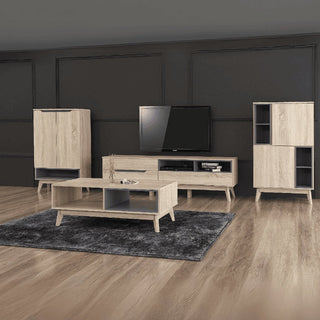Creating a serene bedroom environment is essential for promoting restful sleep and relaxation. One of the most impactful ways to achieve this is through the strategic use of colour schemes. The hues that surround us can significantly influence our mood, stress levels, and overall sense of calm. However, bedroom furniture and decor choices also play a key role in complementing these colours to create a soothing retreat.
In this article, we’ll explore the best bedroom colour schemes to enhance sleep quality and foster a tranquil atmosphere, while also incorporating essential elements of bedroom furniture to optimise comfort and aesthetics.
The Psychology of Colour in the Bedroom

Colours have a profound psychological impact, affecting our emotions and behaviors. In the context of a bedroom, it's crucial to select shades that promote relaxation and tranquility. While personal preferences play a role, certain colours are universally recognised for their calming effects.
Top Calming Colour for Better Sleep

1. Blue: The Ultimate Sleep-Inducing Hue
Blue is often considered the most calming colour, making it an ideal choice for bedrooms. Studies have shown that blue tones can lower blood pressure and heart rate, helping to prepare the body for sleep. Soft shades like sky blue or powder blue are particularly effective in creating a serene environment.
To enhance this effect, pair blue walls with wooden bedroom furniture such as oak or walnut beds and dressers. The natural texture of wood complements the soothing nature of blue, adding warmth and balance.
2. Green: Nature’s Tranquil Touch
Green, reminiscent of lush landscapes, brings a sense of nature indoors. This colour promotes a restful atmosphere, with soft greens like sage or mint offering a refreshing yet calming effect. These shades can help reduce anxiety and create a balanced environment conducive to sleep.
Pairing green walls with upholstered bed frames in neutral tones or rustic bedroom furniture can amplify the connection to nature, making your space feel like a sanctuary.
3. Soft Neutrals: Embracing Earthy Tones
Neutral colours such as beige, taupe, and ivory provide a warm and inviting backdrop for a bedroom. These earthy tones are versatile and can be easily paired with various accent colours to create a cohesive and soothing space. They help in reducing visual clutter and promote a sense of calm.
For a timeless and elegant bedroom, complement neutral walls with modern bedroom furniture, such as minimalist nightstands, sleek dressers, and cosy, fabric-covered headboards.
4. Lavender: A Gentle Embrace
Lavender, a soft shade of purple, is known for its calming properties. This colour can help reduce stress and anxiety, making it a suitable choice for those seeking a peaceful retreat. When used sparingly, lavender can add a touch of elegance without overwhelming the senses.
To create a cohesive look, pair lavender accents with white bedroom furniture, such as a crisp white bed frame and matching nightstands. The contrast keeps the room feeling airy and refreshing.
5. Pale Pink: Subtle Serenity
While often associated with vibrancy, pale pink hues can create a tranquil environment when used thoughtfully. Soft blush tones evoke feelings of warmth and comfort, contributing to a restful atmosphere. Pairing pale pink with neutral accents can balance the colour scheme and prevent it from becoming too stimulating.
For a sophisticated touch, incorporate vintage bedroom furniture, such as a charming vanity table, elegant bedside tables, and soft linen bedding to enhance the warmth of this shade.
Colours to Avoid in the Bedroom

While selecting calming colours is essential, it's equally important to be mindful of hues that may hinder relaxation:
-
Bright Reds and Oranges: These colours are stimulating and can increase energy levels, making it difficult to wind down before sleep.
-
Dark Browns and Blacks: While they can add depth, excessive use of these colours may create a somber atmosphere that could affect mood negatively.
-
Vibrant Purples: Intense shades of purple can be overly stimulating; opting for softer variations like lavender is preferable.
Incorporating Calming Colours into Your Bedroom

Achieving a sleep-friendly colour scheme involves more than just painting the walls. Consider the following elements:
1. Bedding and Textiles
Choose sheets, duvet covers, and curtains in calming colours to enhance the overall ambience. High-quality bedding in soft blues, greens, or neutrals can contribute to better sleep.
2. Accent Pieces
Incorporate decorative items like pillows, rugs, and artwork that complement your chosen colour palette. Soft-hued area rugs and throw blankets can add layers of comfort.
3. Lighting
Opt for warm, dimmable lighting to create a cosy and relaxing environment. Table lamps with soft-glow bulbs on bedside tables can enhance the soothing effect of your colour scheme.
4. Furniture Selection
Selecting the right bedroom furniture is just as important as choosing the right colour. Consider pieces that harmonise with your preferred palette:
-
For blue bedrooms: Natural wood furniture in oak or walnut.
-
For green bedrooms: Rustic or farmhouse-style furniture.
-
For neutral bedrooms: Modern, minimalist furniture with clean lines.
-
For lavender bedrooms: White or light grey furniture for a fresh contrast.
-
For pale pink bedrooms: Vintage-inspired furniture for an elegant, timeless feel.
Conclusion
Creating a bedroom environment that promotes better sleep and relaxation is a thoughtful process that involves careful selection of colours and bedroom furniture. By choosing calming hues like soft blues, greens, and neutrals, and incorporating them into various aspects of your bedroom decor, you can create a serene sanctuary that supports restful sleep and overall well-being.
Remember, the best bedroom is one that reflects your personal style while fostering a peaceful and inviting atmosphere. Invest in quality bedroom furniture, soothing colours, and cosy textiles to transform your space into the ultimate retreat for relaxation and sleep.








